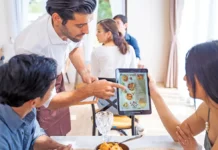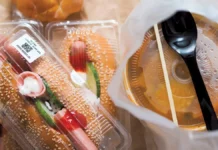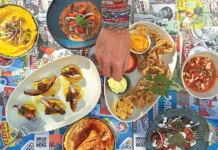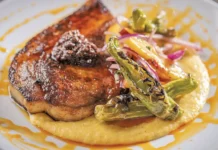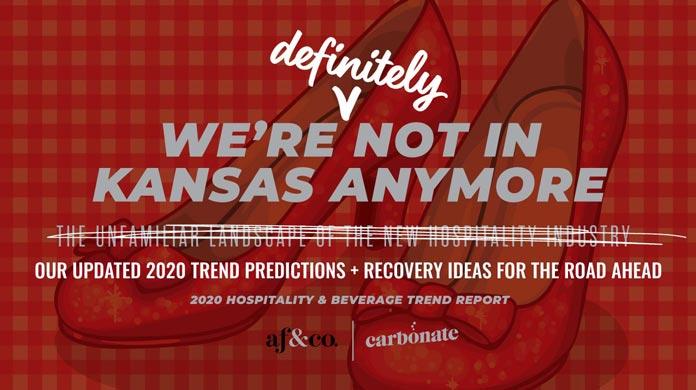
We’re Not In Kansas Anymore: Why the Restaurant Industry Will Come Back Better than Ever
In light of the new normal, af&co. and Carbonate have revisited the 2020 trend report We’re Not In Kansas Anymore: Why the Restaurant Industry Will Come Back Better than Ever. They looked back expecting a completely irrelevant report. What they noticed, however, was that for many of their observations and predictions, quite the opposite was true. The biggest shifts they had observed at the end of 2019 seem to be even more prevalent. Andrew Freeman and the Carbonate team have updated the report with new insights and recovery ideas for the road ahead. We are sharing their predictions on restaurant concepts, food and drink.
RESTAURANT CONCEPTS
Restaurants Get Creative with Delivery and Carryout
Most restaurant kitchens aren’t built for the operational needs of delivery, the fees charged by delivery companies don’t match up with current margins and most restaurant food doesn’t travel well. The idea of transporting a carefully curated in-person experience in a delivery box is at best uninspiring to most chefs and restaurateurs.
* Stay-in-place has forced operators to reconsider these feelings and take a fresh look at how to tackle the only revenue streams that are available — carryout and delivery. While many are doing it as a stop-gap measure, they are starting to see a few emerge with more profitable models. More operators will reevaluate their approach and find ways to make these profit centers work for their particular brand.
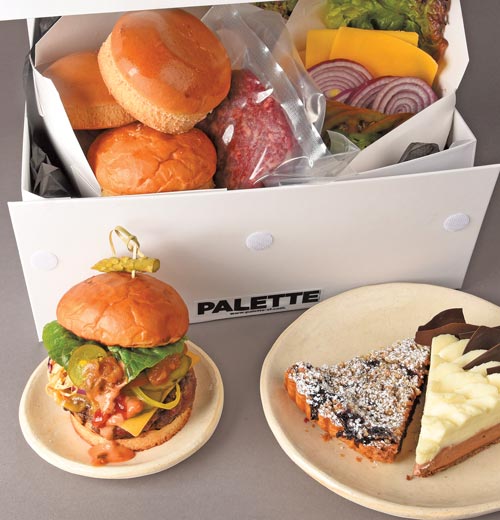
Savvy operators are not asking “How can we do delivery and carryout?” Rather, they are asking, “How can we make it possible for guests to experience what we offer at home?”
Re-framing the question opens a world of possibilities.
* Many restaurants are exploring with family meals, meal kits, house made signature products, retail general stores, and more. Good examples of this range from family sized, make your own taco or pizza kits, take-and-bake lasagna, bottling your restaurant’s signature salad dressing, selling house-made bread retail (custom bags of flour!), etc. Identify what your restaurant is known for, and examine how to recreate some of that experience at home.
Restaurant Brands Examine Their Online Experience
An April 1 brief from Bain & Company, How to Come Out Stronger from the Covid-19 Crisis: Accelerate Simple and Digital, identified several key areas where the COVID-19 crisis is accelerating our digital future. One of those accelerations related to movement patterns: “Movement patterns have flipped. Previously, customers were on the go and enterprises stayed still. Now, customers are housebound and enterprises must find ways to reach them.” This is true more than ever for restaurants.
* This marks a necessary shift in thinking for restaurants from an in-person experience to begin to view their website and social media channels not only as their most important marketing tool, but as the first point of guest contact. It is no longer the person greeting guests at the door that sets the tone for the experience, rather it is their first online interaction.
Multiple Concepts for Multiple Revenue Streams
For a number of years restaurants have been exploring alternate uses of space during the day, particularly in markets where lunch business has declined, such as operating as co-working spaces or converting from grab and go during the day to full service at night. When virus-induced panic buying began, restaurants realized they could support their community and attract revenue by selling items they had access to that regular consumers didn’t, including specialty pantry items, unique bottles of wine, eggs, meats, seafood, flour/yeast, farm boxes, specialty goods, flowers, and even toilet paper.
* This trend will be pushed forward as restaurateurs look to understand, explore and maximize these multiple revenue streams and uses for their restaurant space.
Give Me Some Space (and a Seat Outside)
Updated operational and sanitation guidelines have started to be released and will vary from state to state. While some of these measures will be more prevalent in the short term, temporary precautions have a way of becoming part of our lives. It’s very difficult to back out of cautious behavior. The evolution of airport security over the past 20 years is a good example of this. Technology, convenience and a perception of less risk have very slowly impacted the changes in travel.
* It is fair to assume “temporary” measures that will be enforced while risk remains. More space between tables, contactless payment, plexiglass barriers and even masks may be a part of our lives for quite some time. Additionally, outdoor seating, while always appealing, may become even more coveted. Cities may allow restaurants to expand onto sidewalks, which could be a major help to smaller urban restaurants following what is already being explored in European cities. Bar layouts in particular will also be impacted by this, perhaps with more groups of soft seating and different logistics for ordering.
Taking Better Care of the Essential
COVID-19 has now shined a spotlight for the broader public on the challenges that our industry has faced relating to providing sick leave and health insurance to employees.
* As operators essentially build business models from scratch, we’ll see these issues addressed as a priority — and even more importantly, hope that we’ll also see support and understanding from guests as to how these things impact the cost of a meal.
FOOD
Carbo Comeback
Shelf stable products like rice and pasta have been flying off the shelves. Plus, extra time at home means ambitious cooking projects become a way to take an adventure, with edible rewards. People are tackling sourdough bread, handmade pasta, and all sorts of baked goods.
* Prior to the outbreak, sourdough bread and Detroit style pizza were forecast to be popular this year. Expect those to carry forward – along with a renewed dedication to other fermented breads and artisanal pasta as chefs play and perfect recipes at home.
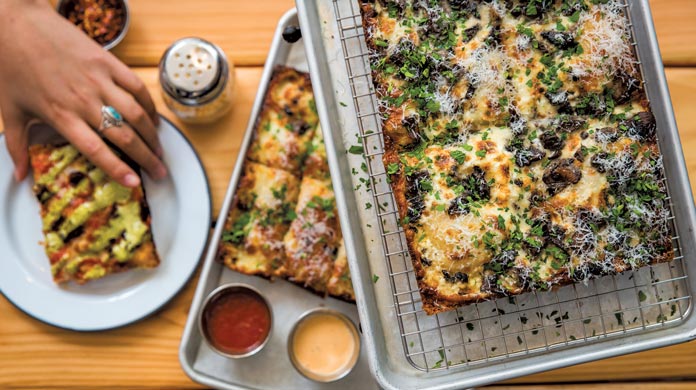
Cross Cultural Comfort Foods
In times of distress, people generally seek out comfort foods. Historically in the US, this would have meant a return to meatloaf, mashed potatoes, stews, braises, fried or roasted chicken, oozy cheeseburgers, and grilled cheese sandwiches, which they fully expect to see.
Over the past few years, however, they have seen cross-cultural cuisine taking new form as Americans adopt flavors from immigrant communities and as chefs pay tribute to their mixed-race upbringings.
* The idea of “authentic cuisine” has lost its traditional meaning, so it’s reasonable that we will also see a lot more comforting dishes with now familiar flavors. Pre-COVID-19, they saw a rise in Italian-Japanese pasta and ramen (itameshi), porridge (from Chinese congee to nordic savory grain bowls), and American BBQ interwoven with Asian dumplings, tacos and Vietnamese sandwiches.
Superfoods Expand with Super Speed
They saw a strong focus on “wellness” impacting a number of aspects of the industry.
* We’ll see this expanding even more with people looking to foods with immunity and other health benefits. In 2019, attention shifted from pure nutritional benefits (vitamins) to functional foods that supposedly enhance performance. Products across the spectrum from breakfast foods to snack bars to cocktails are enhanced with prebiotics (digestive aids) and adaptogens (stress reducers: ex. ayurvedic herbs, medicinal mushrooms).
Sharing Is No Longer Caring
As concerns about the spread of germs are likely to continue, they anticipate that restaurants will rethink share plates.
*Small individual plates or items available “by the piece” will replace most of the communal experience of share plates. Dips and appetizer platters will be served individually, or perhaps not at all. While ever-popular fries and chicken wings may be served in individual fryer baskets, served by the portion.
Can’t Forget Cannabis
It’s not just Cooked with Cannabis on Netflix that’s trending. With dispensary and delivery services being classified as essential in medical and recreational markets, cannabis has become a central part of many consumers’ quarantine while they shelter in place.
They are seeing experiential cannabis event chefs pivoting to at-home meal kits that even replicate the infused dishes seen on the Netflix show’s menu. Eaze, a cannabis delivery company that operates in California, reports a 30% increase in edible sales during the pandemic. As more consumers partake and their consumption comfort increases, we should make way for collaborations, experiential events, and maybe even integrated dining experiences throughout restaurants.
*Even with attitude shifts, there’s still the major hurdle of dining legalization as it applies to cuisine and beverages, but they’re predicting more will be rallying around this approach as an additional opportunity to jumpstart the economy.
DRINKS
Cans Continue their “Can-Do” Attitude

Cans provide convenience and true potential as the virus has forced us all to pack our pantries. Canned cocktails were already on the rise prior to stay-at-home regulations, and sheltering in place only increased the demand for ready-made-drinks at hand.
* Even when we can venture out again, these convenient cocktails will have entered into our routines.
Cocktail Delivery Will Stay… At Least For Now
The team is mixed on when, where, and how lawmakers will reverse back on alcohol delivery laws, but there is already precedent and process in many states with grocery delivery allowing the verification of age at the door.
* Now, as we have proven successful methods of delivery and provided an important financial opportunity for restaurants, regulations will be put in place allowing for smart ways of delivering.
High Proof, Please
One of their favorite trends of 2020 was Non-Alcoholic and Low Proof cocktails. While we love all of the new and interesting NA Cocktails and Low ABV products, American’s purchase of alcohol increased as they prepared to stay-at-home, drink at the ready.
* It’s possible that renewed tastes for strong drinks may lead to higher-proof consumption post sheltering. We may also see a resurgence of simple, spirit forward drinks with less mixology required. The sober curious trend will be back, but may take a little break.
af&co concludes that many business models have to be altered fundamentally to be able to succeed in this new landscape. We will see further disruption as new successful models emerge and old ones die, but this also brings new opportunities for reinvention and acceleration of forces already in motion.


















